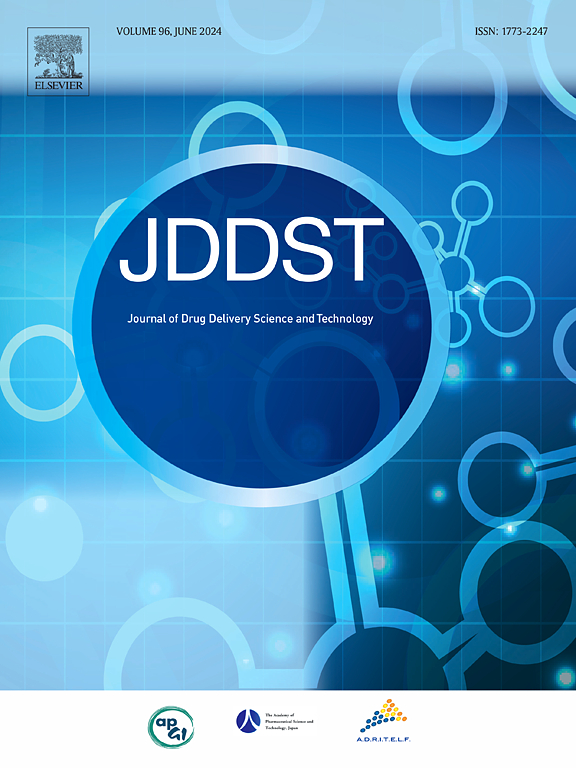烟草茎秆纳米纤维素:流化床造粒中的环保型粘合剂
IF 4.5
3区 医学
Q1 PHARMACOLOGY & PHARMACY
Journal of Drug Delivery Science and Technology
Pub Date : 2024-11-02
DOI:10.1016/j.jddst.2024.106370
引用次数: 0
摘要
多年来,人们一直在寻找可替代现有配方、从自然资源中提取的新辅料。在这种情况下,纳米纤维素(NFC)成为传统辅料的一个重要替代品,这种材料通常从农业废弃物中提取,是一种富含纤维素的材料。大多数情况下,纳米纤维以水分散体的形式出现,形成高度纠缠的纤维颗粒网络,表现出凝胶状行为。因此,本研究旨在探索从烟草茎秆中提取的 NFC 的凝胶状行为,以评估其在流化床造粒工艺中作为粘合剂进一步应用于药物成分的情况。制粒过程采用顶部喷雾模式,进气温度为 80 °C,气流介于 9 至 11 mm3 h-1 之间,雾化空气压力为 0.7 巴。聚维酮(PVP)作为标准粘合剂用于比较。以 3.05 mL⋅min-1 的进料速度将粘合剂系统喷洒在茶碱和麦芽糊精的混合粉末上。对颗粒特性进行了评估,如产量、水分含量、形态、无标记拉曼成像、粒度分布、药物含量和流动特性。采用 NFC 工艺制得的颗粒具有极佳的药物均匀性、低水分含量(2%)、高产率(92%)和良好的流动性。其性能与使用传统 PVP 粘合剂体系制备的颗粒剂相当。因此,这项研究为重新利用烟草茎秆(一种农业废弃物)中的 NFC 作为制粒过程中的替代粘合剂开辟了前景,有助于环境的可持续发展。本文章由计算机程序翻译,如有差异,请以英文原文为准。

Tobacco stalk nanofibrillated cellulose: An eco-friendly binder on fluidized bed granulation
The search for new excipients that provide formulation alternatives over existing ones and that are derived from natural resources has advanced over the years. Emerging from this scenario, an important alternative to traditional excipients is nanofibrillated cellulose (NFC), which is generally obtained from agricultural wastes and is a cellulose-rich material. Most of the time, the nanofibers are presented in aqueous dispersions that form a highly entangled network of fibrous particles that exhibit gel-like behavior. Therefore, the present work aimed to explore the gel-like behavior of NFC from tobacco stalks to evaluate it as a binder in a fluid bed granulation process for further application as a pharmaceutical ingredient. The granulation process was carried out using top spray mode with an inlet air temperature of 80 °C, airflow between 9 and 11 mm3 h−1, and atomizing air pressure of 0.7 bar. Povidone (PVP) was used as a standard binder for comparison purposes. The binder systems were sprayed on the powder blend of theophylline and maltodextrin at a feed rate of 3.05 mL⋅min−1. Granule properties, such as yield, moisture content, morphology, label-free Raman imaging, particle size distribution, drug content, and flow properties, were evaluated. The process using NFC provided granules with excellent drug uniformity, low moisture content (<2 %), high yield (>92 %), and passable flow properties. Their behavior was comparable to that of granules prepared with the classical PVP binder system. Therefore, this study opens a perspective for the reuse of NFC from tobacco stalk, an agricultural waste, as an alternative binder for the granulation process, contributing to environmental sustainability.
求助全文
通过发布文献求助,成功后即可免费获取论文全文。
去求助
来源期刊
CiteScore
8.00
自引率
8.00%
发文量
879
审稿时长
94 days
期刊介绍:
The Journal of Drug Delivery Science and Technology is an international journal devoted to drug delivery and pharmaceutical technology. The journal covers all innovative aspects of all pharmaceutical dosage forms and the most advanced research on controlled release, bioavailability and drug absorption, nanomedicines, gene delivery, tissue engineering, etc. Hot topics, related to manufacturing processes and quality control, are also welcomed.

 求助内容:
求助内容: 应助结果提醒方式:
应助结果提醒方式:


